Small office, home office
By Akhila Thyli Hemanth | 16 Jul 2009
With the increasing traffic congestion (despite all the new flyovers and sea-link routes), and the long travel distances, it isn’t surprising that people seem to prefer to work from home. With more and more people opting for it, a SoHo (Small office/Home office) has become an important space in homes, whether it is a large home or the small apartment. With a bit of planning, organising and attention to the décor and design, your home office will become the ideal workspace.
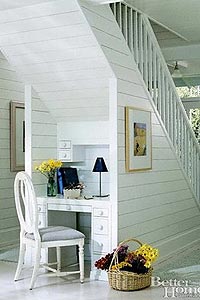 Here are a few tips to create a workspace at home that will become a good productive working environment.
Here are a few tips to create a workspace at home that will become a good productive working environment.
Neera Gulati, an interior decorator who has converted her garage at home into an office, has provided some helpful inputs.
Identify your work place at home
The first thing you need to do is identify an area in your house where you would like to work. Most people make home offices in garages, basements or inside a large closet, but you could also make use of the stair landing or an unused corner of your living room to create your work space. You could also pick a space that has an attached balcony or opens out to the outdoors. If you’re lucky enough to have a separate room for your home office, the task of creating an office won’t be hard at all!
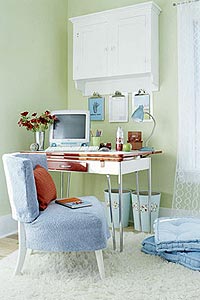 While a home office should be a comfortable working area, it should also be spacious while retaining the professional look, so you get the feel of working in an office itself. It should provide natural light and have good ventilation. Your office should also be able to hold all the top-end facilities that you will require to work in comfort.
While a home office should be a comfortable working area, it should also be spacious while retaining the professional look, so you get the feel of working in an office itself. It should provide natural light and have good ventilation. Your office should also be able to hold all the top-end facilities that you will require to work in comfort.
Converting an attic into an office is a wonderful idea as it will allow you your much needed privacy while working from home without the constant interruptions. An attic SoHo will ensure you have a dedicated working area that’s away from your friends and family. But you’ll need to fit in some windows for natural air and lighting. Basement is another great and common idea for a home office. I have seen many people running their entire business from their basement. It gives them the space required and privacy to run a business. The primary concerns with using a basement as a home office is dampness which may damage computers and other electronic equipment.
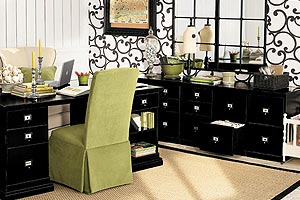 If you are strapped for space, try modifying your stair landing into a small office. You can place a small desk to support your computer and a chair that can be pushed under the desk to save you space. An unused corner of your living room can also work well as an office, and could be to your advantage as it will let in natural light and will be well ventilated.
If you are strapped for space, try modifying your stair landing into a small office. You can place a small desk to support your computer and a chair that can be pushed under the desk to save you space. An unused corner of your living room can also work well as an office, and could be to your advantage as it will let in natural light and will be well ventilated.
Using a garage as a home office is not a bad idea at all. Neera herself has her office in her garage and she has been working wonderfully for nearly a decade now. The garage is technically “outside” your home and this is as good as having a private and independent office of your own without any disturbance from home matters. You can completely transform the garage and give it a more professional look, complete with a professional design and décor suited for an office, customised lighting and electronic systems such as computers, printers and other gadgets that is an indispensable part of work life.
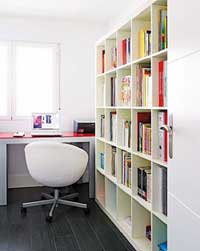 The basic three
The basic three
Some of the basic things to look out for and ensure in office homes is to have the best ventilation, lighting and power.
Ventilation: Many people overlook the importance of ventilation in office design, but you and your office equipment both need it. With heat being generated with office equipment, it can damage office equipments such as your PC. Working can be extremely uncomfortable for you with inadequate ventilation. The room will become a “hot box” making it impossible for you to work in.
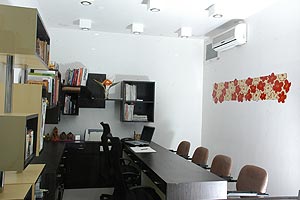 Lighting: When choosing the lighting for your home office, assess your needs first and determine how much illumination you will require to work efficiently and where the light should be placed. An office with inadequate lighting is not only useless but can lead to all kinds of health problems. Light in the home office should be bright enough to provide for a comfortable workspace but not so bright as to create an under glare. There are different choices for lighting the home office. When it comes to general lighting, a ceiling light can work very well. Task lighting can be provided by an assortment of adjustable desk lamps. The right light environment will serve to make the office space much more pleasant and efficient.
Lighting: When choosing the lighting for your home office, assess your needs first and determine how much illumination you will require to work efficiently and where the light should be placed. An office with inadequate lighting is not only useless but can lead to all kinds of health problems. Light in the home office should be bright enough to provide for a comfortable workspace but not so bright as to create an under glare. There are different choices for lighting the home office. When it comes to general lighting, a ceiling light can work very well. Task lighting can be provided by an assortment of adjustable desk lamps. The right light environment will serve to make the office space much more pleasant and efficient.
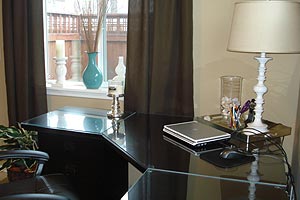 Power: A home office will definitely increase the usage of power– for instance even a small laser printer will consume 300 to 400 watts of electricity when it’s running, and larger laser printers will consume much more. If you have a PC, a laser printer, fax machine and a scanner, make sure you ensure that the circuitry in your home office will be able to cope up with the load. You could use a multifunction machine that performs all the functions in place of a separate printer, fax and scanner.
Power: A home office will definitely increase the usage of power– for instance even a small laser printer will consume 300 to 400 watts of electricity when it’s running, and larger laser printers will consume much more. If you have a PC, a laser printer, fax machine and a scanner, make sure you ensure that the circuitry in your home office will be able to cope up with the load. You could use a multifunction machine that performs all the functions in place of a separate printer, fax and scanner.
Office therapy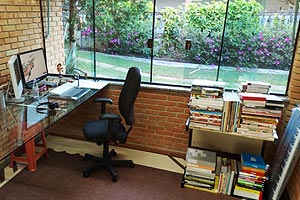 Colours: For the décor of your SoHo, you can add a fresh lively colour or a sedate, calming colour. If you are a more creative person, you can use stencils or wallpaper (See: Dress up your walls) on one wall ( See: Decorating your walls) to design the space.
Colours: For the décor of your SoHo, you can add a fresh lively colour or a sedate, calming colour. If you are a more creative person, you can use stencils or wallpaper (See: Dress up your walls) on one wall ( See: Decorating your walls) to design the space.
Use colours that blend in with your original vision of the place to create a better environment for your home office. Cool colours like green, blue, purple don’t disturb or distract you. These ‘cool’ colours help in relaxing your nerves, soothing the soul, lifting your spirits, and they also facilitate concentration.
Warm colours like yellow, red and orange are active and lively hues and give a vibrant and intimate look. These colours are truly invigorating and cheerful. People who are looking for stimulation and sparks in their work place can use these colours. These colours can awaken you mind and enliven your mood. However, due to the lively characteristics of these hues, they sometimes tend to become a distraction.
White has always been a symbol of purity and peace. Smaller areas tend to appear spacious with the use of whites.
So choose a colour according the mood and the environment you would like to create for your workspace.
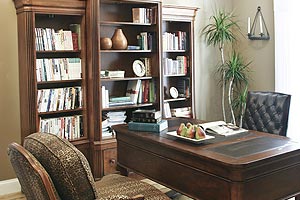 Furniture: Long hours are spent in front of the computer, so the furniture used in your home-office should be ergonomic as this helps in maintaining a good posture. Poor posture can lead to a lot of health issues, including back pain and wrist ache. Giving special attention to the furniture that you will be investing in will ensure you avoid any kind of postural problems.
Furniture: Long hours are spent in front of the computer, so the furniture used in your home-office should be ergonomic as this helps in maintaining a good posture. Poor posture can lead to a lot of health issues, including back pain and wrist ache. Giving special attention to the furniture that you will be investing in will ensure you avoid any kind of postural problems.
Get personal and private: The lack of privacy is sometimes an issue for people working from home. They are taken for granted and there is a complete disregard for their private workspace. A little effort an make sure that the intrusion and noise levels are controlled. Wooden panels will offer you a secluded place to work in, while some modern-day solutions include sound-proofing your walls.
Naturally refreshing
A home office filled with plants makes the atmosphere more calm and relaxing besides the obvious health benefits that plants offer. They cleanse and purify the surrounding, and refresh the passing air. Interior plants (See: Indoor plants) have been shown to improve interior air quality, reducing sickness of occupants. Research says that company administrators have noticed enhanced creativity and increased productivity in employees who have plants in their workspace.
Planning and preparing a home office may be a challenge for the end result will be fulfilling and productive.






























